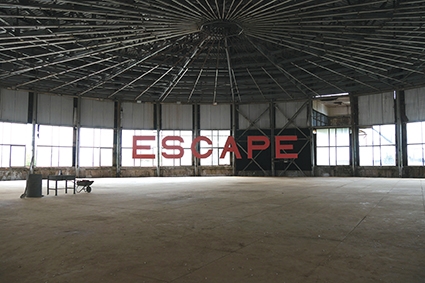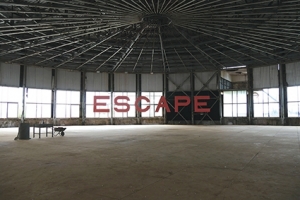Surviving Society: Illegal Kosmonavtika, Exhibition
REVIEW
Head over to the Institute of Space Structures in Saguramo, outside Tbilisi, before July 22 to see an exhibition that gathers various installations and workshops around a fascinating theme.
The building now housing the Institute of Space Structures was created in 1979 as the former Soviet Georgian Space Program but very little is known about its purpose. The only well-known program was the construction of a Georgian satellite called “Reflector,” put into orbit in 1999. One of the buildings in the complex, an anti-gravity pool, was demolished and the metal within sold. The Institute’s hidden location and the fact that it was abandoned in 2006, and, further, that it has remained unexploited until very recently, constitutes the perfect framework for the abovementioned exhibition.
In fact, these off-road abandoned buildings are nowadays the symbol of a society that is forgetting its past and that is perhaps trying to avoid questions by allowing such remnants to be destroyed, so preventing future generations from the chance of understanding what happened. This is precisely what the Soviet Union looks like to the young generation: a blurry era of issues which this exhibition aims to dig up by questioning propaganda and state secrets through different generations of artists, from those who knew socialist realism and the monopoly of the state, to their younger contemporaries.
The display includes installations by artists Mariam Natroshvili and Detu Jincharadze, making a “ghost” museum of Unidentified Files, gathering different material related to the most important constituent of Soviet utopia, the conquest of space. Ana and Tamara Chaduneli explore the influence of advertising on society, both in the Soviet system propaganda, which promoted utopian ideals, and within the current system; emphasizing the fact that while the techniques may have changed, the desire to control remains the same.
Besides the display of works, the exhibition also included the workshop “protest aerobics” which involved “conceiving, developing and examining” efficient physical forms of protest, run by the Group Bouillon collective.
The exhibition also brings into question the monopoly of states and corporations nowadays, those which failed to disappear with the collapse of the Soviet Union, attempting to imagine a similar scenario for today’s structures.
The term ‘Illegal Kosmonavtika’ itself was coined by Georgian artist Zura Jishkariani and refers to an individual with rudimentary skills for survival in such case the current system also fails. And this precisely involves transgressing from the norm imposed by greater interests, be they legal, economic or social.
The exhibition uses its location to emphasize space conquest and introduce the possibility of a space program based on people, with space already being colonized by both state pride and propaganda, and corporate interests, taking as examples the project of mines on Mars. Those ‘Illegal Kosmonavtika’ among us should first overcome financial problems, surveillance and even mockery in order to achieve their goals. But the exhibition advocates, through its different installations and workshops, drawing on do-it-yourself solutions in order to achieve great things, such as discovering new territories.
The display is on at the Institute of Space Structures in Saguramo, 30km north of Tbilisi. Further details about participants, venue and the theme of ‘Illegal Kosmonavtika’ can be found on the official website of apexart, a non-profit art organization.
David Mongazon











